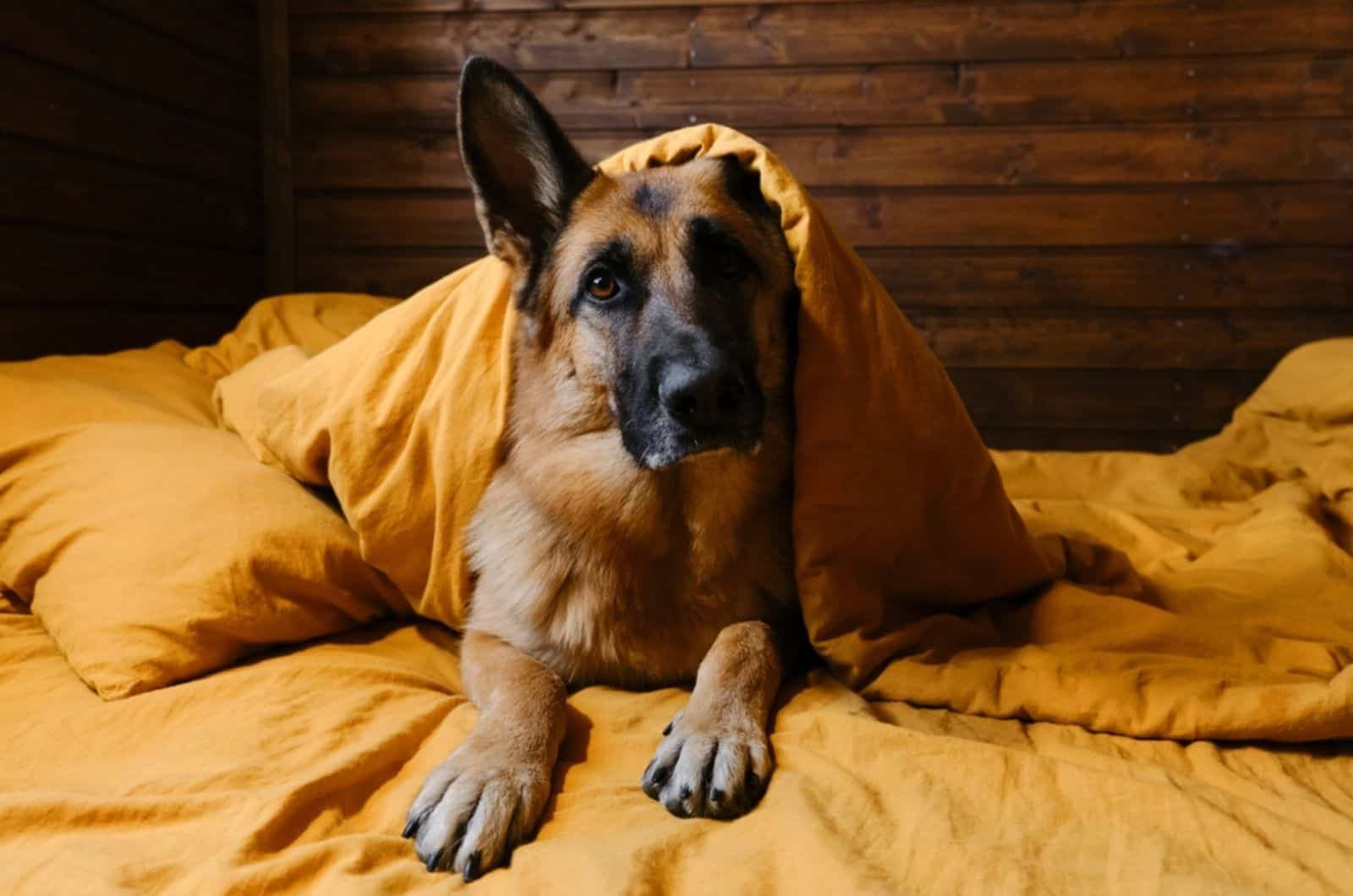Does the prospect of a dog shivering in the cold snow and frozen sidewalk send chills down your spine? If you envision a GSD, then know that German shepherd cold tolerance is decent.
What does decent mean? Well, it means the breed has its limits for low-temperature resistance and that there are plenty of factors other than coat length that influence German shepherd cold tolerance.
Not all breeds are made the same (duh!), so their resilience to freezing winter climates will vary. Since you are curious about German shepherd cold tolerance, let us see how the breed fares in cold weather.
How Low Can German Shepherd Cold Tolerance Go?
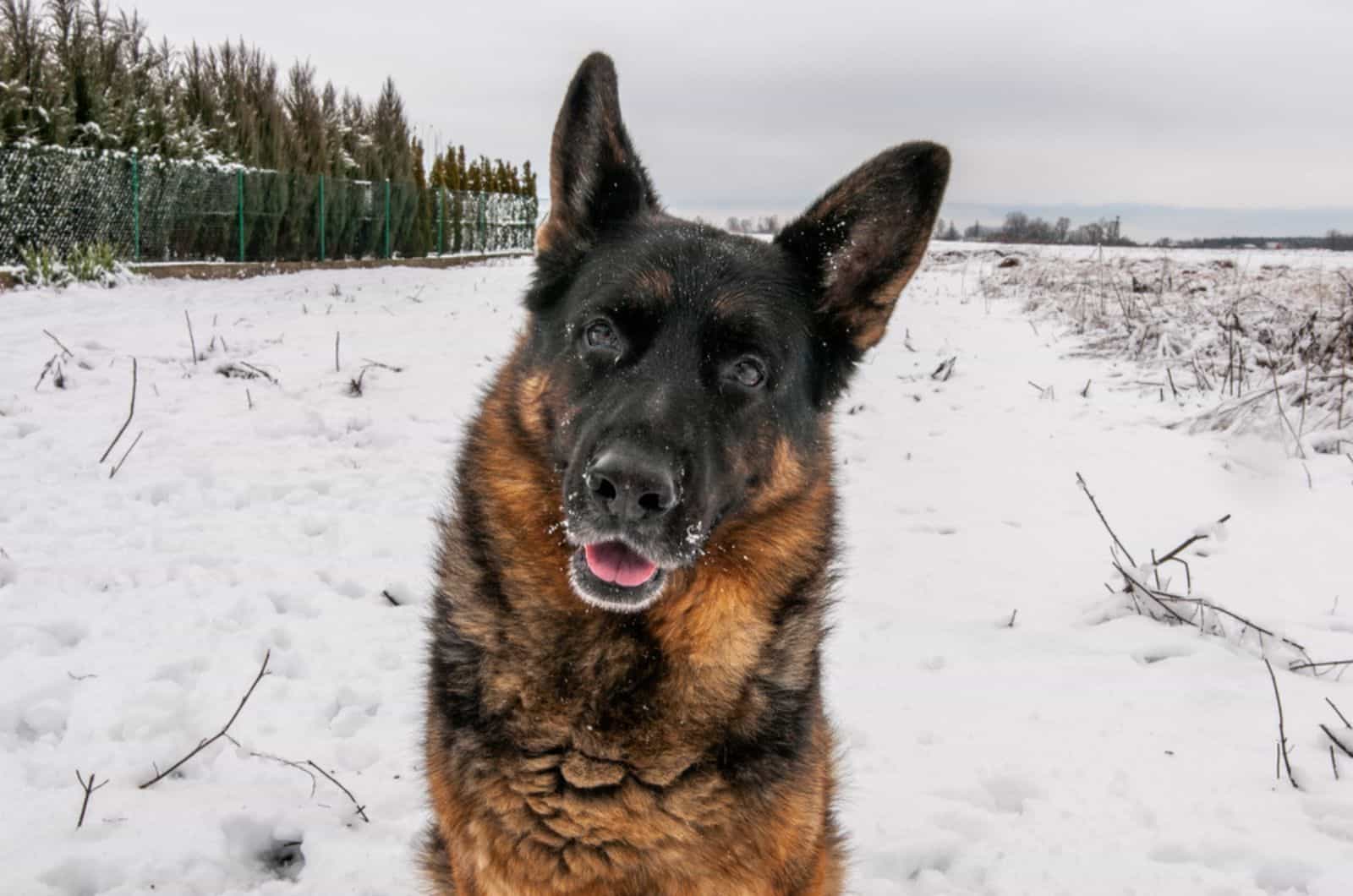
The most obvious feature that determines the resistance to low-temperature tolerance is the length of the outer coat and the absence or presence of an undercoat. The German shepherd has medium-length guard hair or an outer coat and a softer coat just under that.
Twice per year, a German shepherd will shed the undercoat, which means it will leave a lot of hair behind to get rid of the old summer coat in favor of a fluffier winter coat. Interested in just how much they shed? Here is an article on all things German shepherd shedding.
With a double coat, German shepherd cold tolerance goes pretty low, but that is not the only thing allowing this dog breed to withstand temperatures below thirty-two degrees Fahrenheit.
The Surface area of the German shepherd’s body plays a major role in dissipating heat, which means the larger the dog, the more heat it will release from its body. However, the inner body is the part that keeps the dog warm, so its volume is equally important.
Smaller dogs are naturally worse at keeping warm in cold weather. Their inner body volume is not proportionate to their outer body surface, so they let more heat escape through the skin than their internal body heat mechanisms can produce.
This is another plus for German shepherd cold tolerance as it is a large dog breed and their internal body volume can keep the warmth despite a large surface area. If you have a dog with some “belly fat” all around, it will have better cold tolerance.
In their prime years, German shepherds will have very high cold tolerance, but German shepherd puppies or senior dogs, the ability to preserve heat within their bodies is going to be lower. Similarly, a dog with a health condition might have problems controlling its body temperature.
A German shepherd that lives in a region where winters are long, and summers short will develop higher cold tolerance than a dog that lives in a warm climate. Short-haired German shepherds will not have the same cold tolerance as those with a longer coat.
External Factors That Affect German Shepherd Cold Tolerance
While the individual dog’s ability to keep warm is also a factor, external factors like wind chills, air humidity, precipitation, cloudiness, and physical activity also make a big difference in preserving warmth.
- Breezes in colder temperatures are like razors of chill that can easily cut through your German shepherd’s coat.
- Despite the presence of a double coat, if the air is humid or it is snowing or raining, a wet coat will be a heat sucker for any dog.
- Absorbing heat from the sun is key for most dogs. When the weather conditions are not ideal but there is sun, your dog will most likely be fine. An overcast day in the winter months will feel much colder than one with clear skies.
- Cold or not, a German shepherd will love outside physical activity. Since they are a high-energy breed with substantial muscle mass, producing excess heat from moving around will keep them warm for at least half an hour.
How Cold Is Too Cold For A German Shepherd?
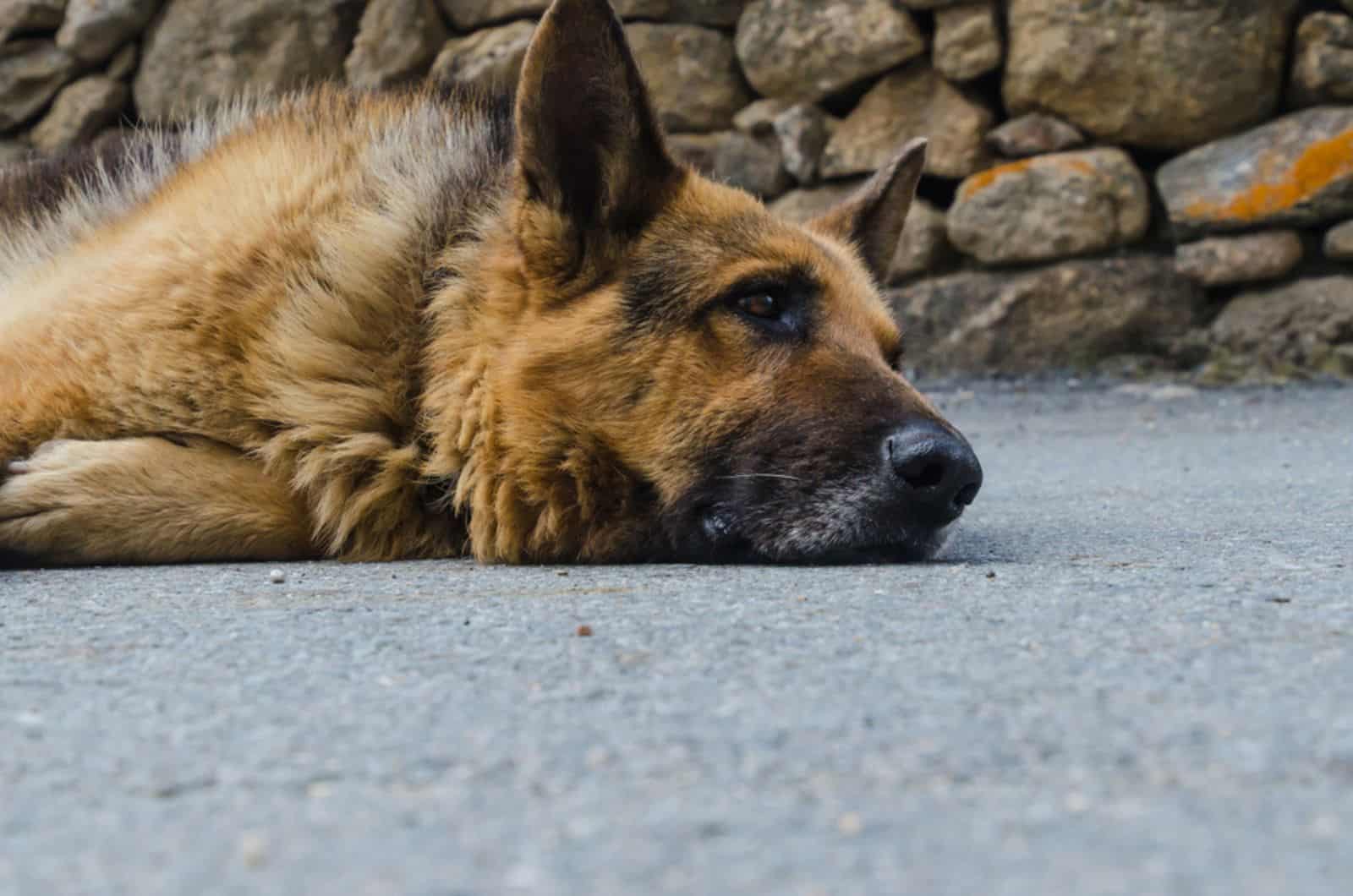
As you already saw, there are plenty of things that influence German shepherd cold tolerance. Many of them can be inhibited by health conditions or external factors, but there is a general guideline for the lowest temperatures a GSD can tolerate.
One thing we have not mentioned so far is the German shepherd’s specialized paw pads. They are highly vascularized, which means there is a well-developed network of blood vessels in the feet. This is very important when walking on freezing concrete or snow.
Considering you are not going to spend long periods of time in extremely cold weather with your GSD, the lowest temperature they will be able to tolerate for a short period of time is twenty degrees Fahrenheit.
Below-freezing temperatures should be avoided if possible, but they will not hurt your German shepherd if you are taking it for a short walk or to pee and poop.
Reading The GSD Body Language To Know When It Is Time To Bounce
German shepherds relish playing outside more than anything. The snow is often one of the things dogs get excited about the most. I know my Belgian Malinois becomes a snowplow with ears with the first serious snowfall.
While large-breed dogs can keep warm for a while, they are not big subscribers of the theory that there is such a thing as being too cold. Colder weather definitely calls for a close eye on signs that mean you should probably get your GSD out from the cold.
Keep A Close Eye On This Kind Of Behavior
Your dog will have hindered movement or stop moving altogether if the cold is seriously affecting it. Puppies might whine to let you know it is well below the German shepherd cold tolerance level.
Being a vocal breed, the German shepherd dog will also howl or bark (higher pitched than a normal bark) when it becomes too cold. Although this behavior is more common in puppies, an adult GSD that howls, whines, or barks requires immediate removal from the cold.
Read more about the German shepherd howling, 9 causes, and how to prevent it. While we’re at it, here is how to train your GSD to learn when to bark.
Shivering is perhaps the most obvious and common sign of your dog being too cold. It is crucial to immediately react to shivering, as that indicates that your dog’s temperature is rapidly dropping.
Their ancestral ties to the wolf will sometimes prompt a quick search for the best place for burrowing. By digging a hole in the snow or ground they will look to find shelter from wind or snow, and keep warm.
Contracted back muscles that make your German shepherd appear hunched and a tail between its legs are signs that the dog’s attempts to stay warm were unsuccessful. Hypothermia does not take long to develop after these behaviors.
If somehow you did not manage to get to a warm place and hypothermia does ensue, your dog will have bluish gums due to constricted blood flow.
The Dangers Of Hypothermia
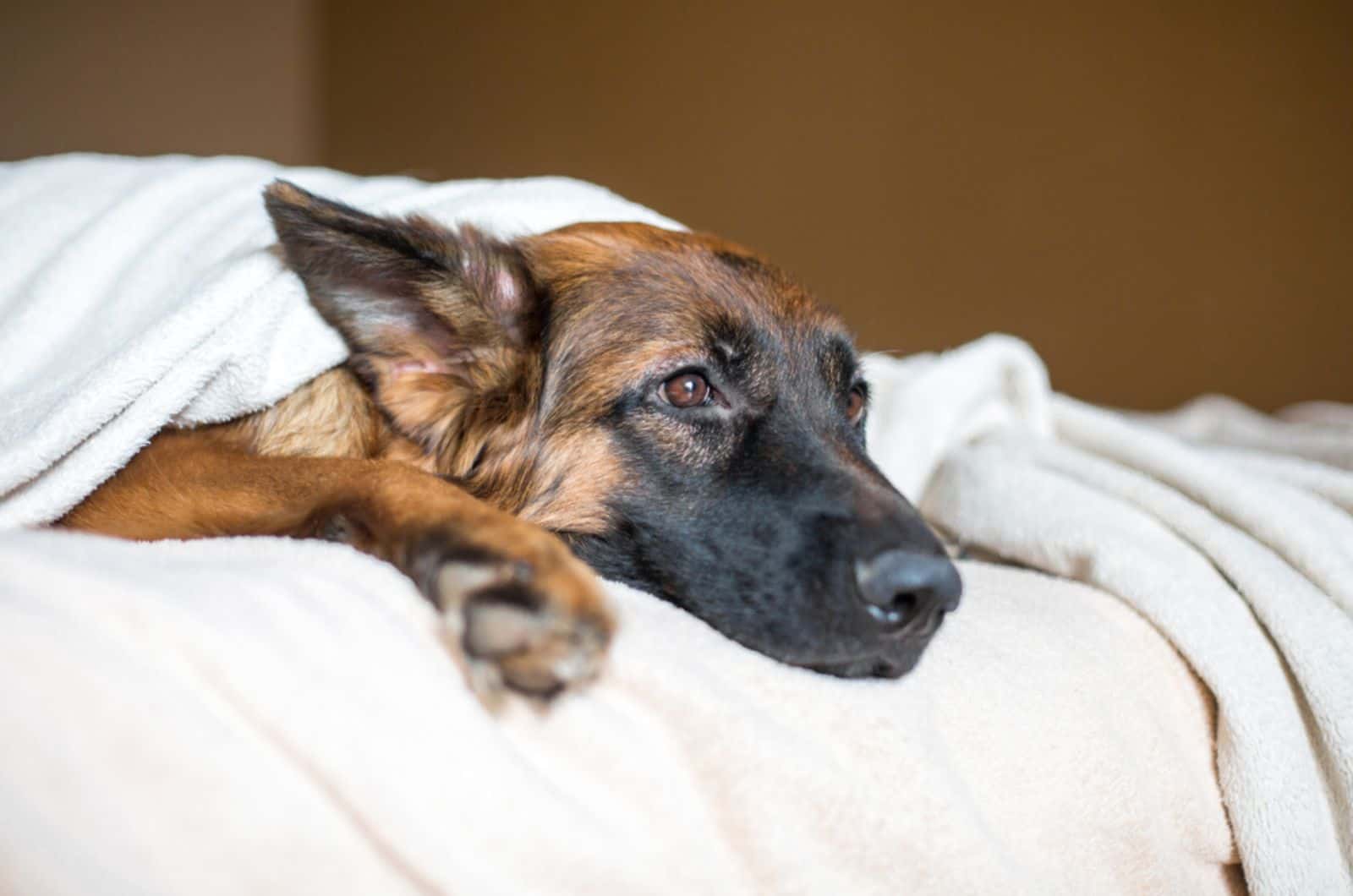
Many people confuse being cold with having hypothermia, but those two things are completely different. When a dog is cold, it means its fur coat is not enough to keep it warm but its body temperature is not dropping dangerously.
Thanks to their body mass and high activity level, German shepherds can maintain the normal temperature for a dog which is between one hundred point five and one hundred two point five degrees Fahrenheit.
However, only a degree or two lower and you are looking at a hypothermic dog. Ninety-eight or ninety-nine degrees are a tell-tale sign of the onset of hypothermia, which means your dog was in the cold for far too long.
What Symptoms To Look For?
While shivering and having difficulty walking are also symptoms of being cold, they are warning signs that should not be ignored. Stiff muscles and confused behavior are already an indication of hypothermia.
If your GSD suddenly stops shivering while still in the cold it means its body temperature has dropped too much, and the possibility of temperature-induced collapse will drastically increase.
The above behavior is a sign of moderate hypothermia, which is already a red flag that your dog’s temperature must be increased as soon as possible. Let us see what the clinical signs of severe hypothermia are.
Fixed and enlarged pupils should be a reason to urgently get your German shepherd to a warm place or rush to the vet since these symptoms usually precede negative changes in heart rate and breathing. Not responding to stimuli can be a sign of brain damage caused by cold temperatures.
Dogs with underlying health conditions are at a greater risk of developing hypothermia sooner. The consequences can be much worse, and the success of recovery is also significantly reduced in dogs with health problems.
Treatment Options
The best way to counter mild or moderate hypothermia is to raise your dog’s body temperature gradually. Going from twenty to a normal room temperature of seventy degrees Fahrenheit can be a shock for the body, and your dog might develop complications or get tissue damage.
Using any heating sources like hair dryers, heating pads, radiators or heaters is not advisable as they can cause burns to the skin that is potentially also affected by frostbite.
Put your German shepherd in a blanket but do not rub its body. Damage to the tissue can be aggravated by putting pressure or friction on the skin. Additionally, you can use your own body to transfer the heat through the blanket.
Although putting a source of heat directly by the dog is bad, heating up the blanket or clothing that you plan on wrapping around the dog can be beneficial.
Lastly, make sure you take your German shepherd to the vet as soon as its body temperature starts returning to normal. Note that the best thing to do is go to an animal hospital immediately while raising your dog’s body temperature.
Medical treatment usually consists of warm intravenous fluids that are given directly into a dog’s stomach or another body part that can receive IV solutions. Masks that provide warm and humidified oxygen can be used, depending on the extent of damage to the body.
Survival rates are good with mild and moderate hypothermia, but severe hypothermia can cause vital organ damage and tissue damage. Dogs that become comatose have a much less favorable prognosis, but not all is lost there either.
What Is Frostbite And How To Deal With It
Long exposure to cold temperatures will start constricting blood flow in the extremities as the body redirects blood into the brain, heart, and other vital organs.
Frigid temperatures of under twenty degrees will be too much for the German shepherd’s thick double coat, but your dog’s paws are most frequently the first to suffer from frostbite.
Other body parts that can quickly become damaged by cold are the ears and tail. However, these are not the only areas of tissue that can become frozen during long exposure to freezing temperatures.
Frostbite can affect the perianal and genital areas, too. The skin on these parts of the body is much more sensitive than the paw pads, which means frostbite will penetrate the tissue quicker and sooner.
A German shepherd uses its bushy tail to cover those parts once it gets too cold. This behavior usually means the dog’s movement will be slower due to the tail essentially being between the legs to keep the area warm.
Dogs will more often than not ignore frostbite because it does not hurt immediately. The only way to make sure your dog remains “unfrostbitten” is to be proactive about getting away from the cold. German shepherd cold tolerance will be lower after recovering from frostbite.
Symptoms
Where there is frostbite, there is usually a pale skin tissue color. This is a sign that the capillaries in that region of the body do not have sufficient blood. Naturally, the same areas will also be very cold to the touch or feel brittle.
It is important to note that most frostbite symptoms appear days after being exposed to the cold. This is why prevention is the best option when spending time with your GSD in cold environments.
If you see a painful reaction in your German shepherd while touching areas that you believe are affected by frostbite, do not delay going to the vet. Despite there being a lack of oxygenized blood in the frostbitten region, there can be visible swelling and blisters or ulcers.
The worst symptom by far is necrotic tissue. It appears as a black portion of skin and is very painful. Necrotic tissue cannot regrow or be repaired but instead removed to stop its spread.
Treatment
In case you notice frostbite marks on the dog, do not apply friction to the affected area. The damage to the skin makes it very fragile, opening it to the possibility of more severe injury.
Warm water (not hot enough to be uncomfortable to the touch) should be used with a compress to soak the area. Hair dryers or pads will do more harm than good, so never consider using them.
Most cases of frostbite are not too serious and can be treated with the removal of the necrotized tissue and antibiotic therapy to reduce the chance of bacterial infections spreading to the surrounding skin or organs.
Dogs that are exposed to the cold for too long can have severe frostbite. The consequences might involve amputation of the affected extremities or even be fatal if the infection from the dead tissue spreads to vital organs.
What If My German Shepherd Lives Outside The House?
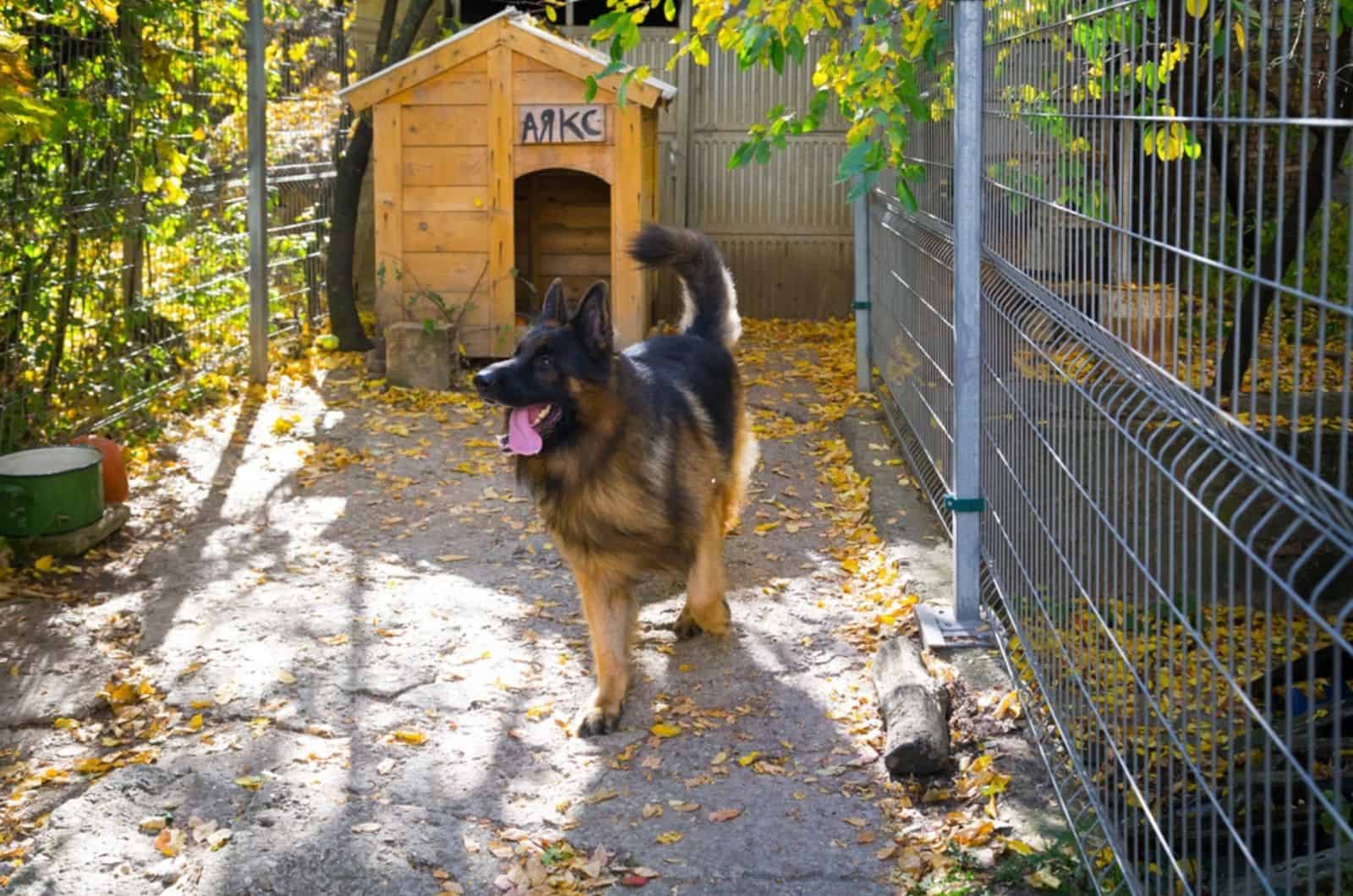
While there are dog breeds that are absolutely fine living outside in the coldest and harshest of climates, the German shepherd cold tolerance factor is not as high as, let us say, an Alaskan Malamute’s or a St. Bernard’s.
Those dogs are equipped with longer hair and a thicker undercoat to cope with extreme temperatures. Additionally, dogs that live exclusively in cold weather are more adept at resisting cold temperatures and the unfavorable external factors we mentioned at the beginning.
Your GSD’s well-being will depend on having adequate shelter from wind and snow. A fence high enough to prevent gusts of snow and running off is equally important if you live near any bodies of water.
Freshwater lakes are a major hazard for dogs. The frozen surface is rarely thick enough to withstand the weight of the German shepherd, so falling into the freezing water below would be a death sentence.
A well-built dog house with insulation and a strategically positioned entrance with a waterproof cover will keep your dog warm and dry. Adding some hay or blankets inside the dog house is a great way to make it more “homey”. Make sure that the spot where the house is dry.
Styrofoam can be used as insulation in combination with wood panels. Remember that the entire house should be elevated from the ground to help keep the cold of the soil or concrete from nullifying the warmth inside the dog house.
Always have a bowl of water near the home in case of heavy precipitation. Hydration is important in the process of body temperature regulation in dogs.
Conclusion
Pretty sturdy animals these German shepherds, are they not? They are not the best pick if you live in the sub-polar region or Siberia, but northern hemisphere winters will not be difficult to survive with the German shepherd cold tolerance level.
No matter where you live, you should not allow your dog to be outside in freezing temperatures for long periods of time. A soaking wet coat and winter winds can cause hypothermia and frostbite that much sooner, so keep playtime sessions under half an hour.
It is much better to get warm and go out again than to worry about what the vet will say. Before going out with your GSD, especially if it is a puppy or senior dog, prepare for any scenario.
Bring a blanket and dog sweaters, stay off of frozen lakes, ponds, etc., and most importantly, manage your time wisely. Playtime can make you lose track of time, but a dog’s well-being should be the primary concern.
Read Next: 17 German Shepherd Signs Of Affection: How A GSD Shows Love
